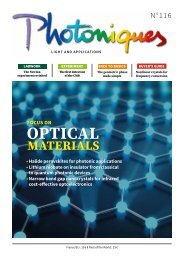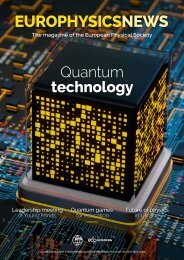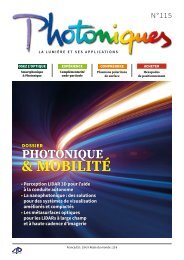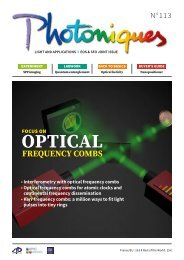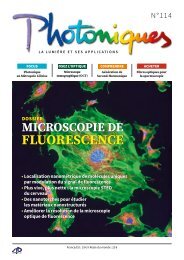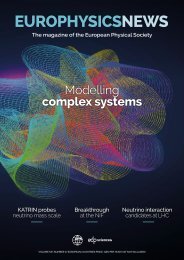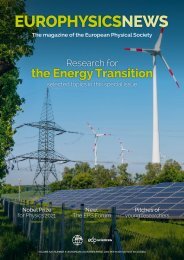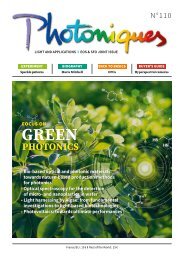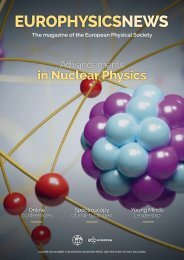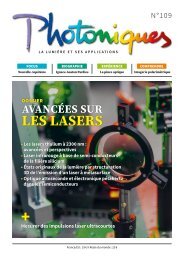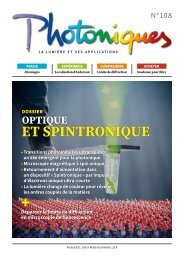EPN 53-3
You also want an ePaper? Increase the reach of your titles
YUMPU automatically turns print PDFs into web optimized ePapers that Google loves.
HIGHLIGHT FROM EPJ PLUS<br />
IN THE SPOTLIGHTS<br />
Impact of medical and imaging physics<br />
on the COVID pandemic<br />
The COVID pandemic has had a profound global impact, a new collection of papers<br />
looks at a multidisciplinary approach to aspects of the pandemic.<br />
The COVID pandemic has impacted<br />
every aspect of our lives<br />
over the past two years. It is little<br />
surprise then that this crisis has<br />
united a wealth of disparate fields of science<br />
in attempts to mitigate the virus and its effects.<br />
A new focus issue of EPJ Plus collects<br />
together invited papers that detail the<br />
impact of medical imaging and medical<br />
physics technology on various aspects of<br />
the COVID pandemic. The focus issue is<br />
guest-edited by Evaristo Cisbani and Franco<br />
Garibaldi, both from Istituto Superiore di<br />
Sanita, Rome, and Istituto Nazionale di<br />
Fisica Nucleare, Rome, along with Stephanie<br />
Majewski, UC Davis, California, USA, and<br />
Andrea Gori, University of Milano, Italy.<br />
“The focus issue deals with Molecular<br />
imaging techniques applied to Covid<br />
19. This is just the right time for such a<br />
collection, as we believe we have now accumulated<br />
enough data and information,”<br />
Garibaldi says. “We have had the problem of<br />
COVID for the last two years and we must<br />
be prepared for possible future pandemics.”<br />
One particular aspect of the COVID infection<br />
looked at by the collection and its<br />
authors is inflammation. This is one of the<br />
primary causes of severe sickness, especially<br />
in those with underlying health conditions<br />
such as diabetes.<br />
In their Editorial, the guest editors of the<br />
focus issue say that new advanced technologies<br />
already available in the research field<br />
and undergoing constant improvement<br />
could translate into increased sensitivity<br />
of early detection and avoiding the longterm<br />
side effects of inflammation.<br />
The key to this is understanding what<br />
actually needs to be imaged or visualised<br />
and what the emerging imaging needs<br />
are. Thus, the editors asked experts to address<br />
the biomedical issues related to the<br />
COVID-19 pandemic and associated inflammatory<br />
effects.<br />
The editors lay out the multidisciplinary<br />
focus points for the topical collection papers<br />
as: the origin and evolution of COVID infection<br />
from a biological perspective, diagnosis<br />
and early differentiation of COVID-19 from<br />
other diseases, and the role of advanced detection<br />
technology including medical physics<br />
and artificial intelligence. n<br />
Reference<br />
[1] Focus Point Issue “Progress in medical<br />
physics in times of CoViD-19 and related<br />
inflammatory diseases”, Guest Editors:<br />
E. Cisbani, F. Garibaldi, S. Majewski, A. Gori,<br />
Eur. Phys. J Plus (2022)<br />
FIG. 1:<br />
Top: T-cells can<br />
be detected by<br />
a PET scan of<br />
the total body<br />
(courtesy of UC<br />
Davis EXPLORER<br />
group); bottom:<br />
18F-FDG PET<br />
scan shows<br />
unsuspected<br />
pulmonary<br />
thrombi in<br />
COVID-19<br />
patients.<br />
<strong>EPN</strong> <strong>53</strong>/3 11



